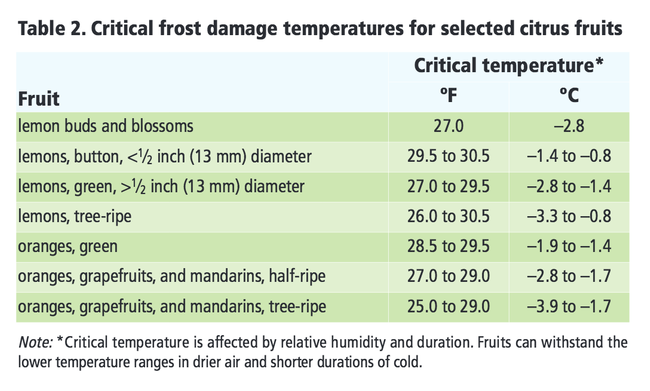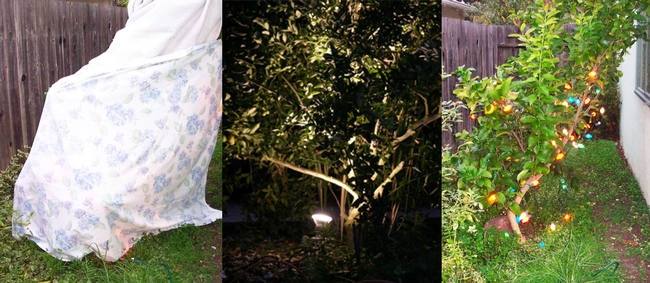By Brent McGhie, Butte County Master Gardener, November 27, 2015.
Freezing temperatures damage plants by causing ice crystals to form in their cells. Frost-damaged vegetation withers and turns a dark brown or black. Ice crystals can also form in citrus fruit, causing juice vesicles inside the fruit to rupture and the fruit to dry out. Although frost-damaged fruit is edible after a freeze, it is susceptible to decay and often becomes unusable soon after the damage occurs.
Leaves, green wood and fruit are more frost sensitive than hard wood. Ripe fruit is more cold tolerant than green fruit because sugars in the juice act like antifreeze and lower the temperature at which it will freeze. Fruit is slightly less cold tolerant than leaves, and trees with fruit are less tolerant than trees without fruit, so in addition to preventing damaged fruit, picking fruit before a predicted freeze will not only save the fruit, but will help protect the entire tree as well.

Where a tree is planted can affect whether or not it is damaged by frost. Trees that are growing in open areas are more likely to suffer frost damage. Cold air tends to collect in low areas, so avoid these sites as well when planting citrus. On the other hand, trees can benefit from reflected and reradiated heat if they are planted near walls or other structures.
Certain cultural practices can also mitigate frost damage. Healthy, well-irrigated trees are better able to endure freezing temperatures. The full, leafy canopy of a healthy tree also helps shelter the fruit. In addition, moist soil retains heat better than dry soil and can actually warm the air near the soil surface. It is also a good idea to keep the ground around trees bare during the winter months. Bare, moist soil is better able to absorb and reradiate heat than soil insulated with mulch, weeds, or other ground covers. Fertilizing and pruning both encourage new growth, and delicate new growth is far more frost-sensitive than mature foliage. Thus, pruning and fertilizing of citrus trees should occur in the spring and early summer in order to give the new vegetation time to mature and harden off before cold weather sets in.

Frost-sensitive young trees can be protected by wrapping them with insulating material from the ground up to the main branches. In frost-prone areas, you might also consider covering trees that are one to three years old entirely, using a light material to trap heat being radiated by the ground. A frame or stakes should be used to minimize contact between the cover and leaves because ice may form where the cover touches any leaves. Sheets, burlap, or tarps are a better choice of cover material than plastic because plastic transfers more heat and if leaves come in contact with it they are more likely to freeze. The cover should extend as close to the ground as possible and be removed the next morning after the temperature rises.
If trees do show signs of frost damage, resist the urge to prune out “dead” wood in the early spring. Allow a few months for the trees to recover with the return of warm weather. Once new growth appears, the actual extent of the frost damage will be apparent and frost-killed branches can be removed without accidentally pruning out living material.
This article was based on information from the following sources:
http://homeorchard.ucdavis.edu/8100.pdf
http://ucanr.edu/sites/placernevadasmallfarms/files/135464.pdf